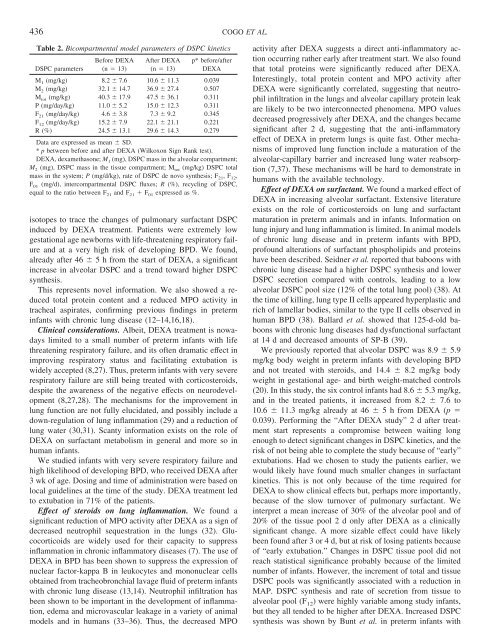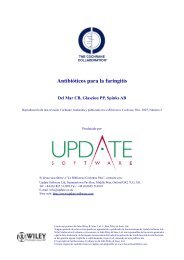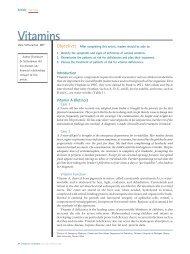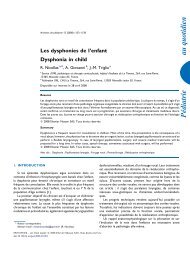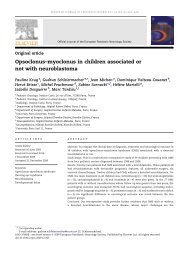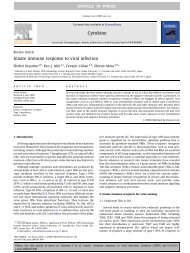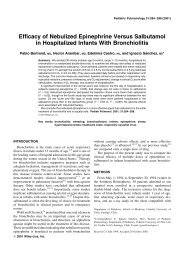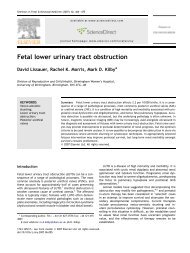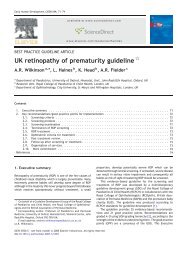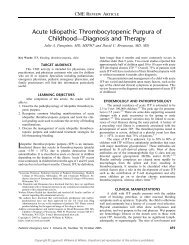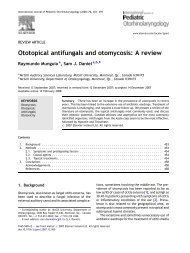Dexamethasone Therapy in Preterm Infants Developing ... - sepeap
Dexamethasone Therapy in Preterm Infants Developing ... - sepeap
Dexamethasone Therapy in Preterm Infants Developing ... - sepeap
You also want an ePaper? Increase the reach of your titles
YUMPU automatically turns print PDFs into web optimized ePapers that Google loves.
436 COGO ET AL.<br />
Table 2. Bicompartmental model parameters of DSPC k<strong>in</strong>etics<br />
DSPC parameters<br />
Before DEXA<br />
(n 13)<br />
After DEXA<br />
(n 13)<br />
p* before/after<br />
DEXA<br />
M 1 (mg/kg) 8.2 7.6 10.6 11.3 0.039<br />
M 2 (mg/kg) 32.1 14.7 36.9 27.4 0.507<br />
M tot (mg/kg) 40.3 17.9 47.5 36.1 0.311<br />
P (mg/day/kg) 11.0 5.2 15.0 12.3 0.311<br />
F 21 (mg/day/kg) 4.6 3.8 7.3 9.2 0.345<br />
F 12 (mg/day/kg) 15.2 7.9 22.1 21.1 0.221<br />
R (%) 24.5 13.1 29.6 14.3 0.279<br />
Data are expressed as mean SD.<br />
* p between before and after DEXA (Wilkoxon Sign Rank test).<br />
DEXA, dexamethasone; M 1 (mg), DSPC mass <strong>in</strong> the alveolar compartment;<br />
M 2 (mg), DSPC mass <strong>in</strong> the tissue compartment; M tot (mg/kg) DSPC total<br />
mass <strong>in</strong> the system; P (mg/d/kg), rate of DSPC de novo synthesis; F 21 ,F 12 ,<br />
F 01 (mg/d), <strong>in</strong>tercompartmental DSPC fluxes; R (%), recycl<strong>in</strong>g of DSPC,<br />
equal to the ratio between F 21 and F 21 F 01 expressed as %.<br />
isotopes to trace the changes of pulmonary surfactant DSPC<br />
<strong>in</strong>duced by DEXA treatment. Patients were extremely low<br />
gestational age newborns with life-threaten<strong>in</strong>g respiratory failure<br />
and at a very high risk of develop<strong>in</strong>g BPD. We found,<br />
already after 46 5 h from the start of DEXA, a significant<br />
<strong>in</strong>crease <strong>in</strong> alveolar DSPC and a trend toward higher DSPC<br />
synthesis.<br />
This represents novel <strong>in</strong>formation. We also showed a reduced<br />
total prote<strong>in</strong> content and a reduced MPO activity <strong>in</strong><br />
tracheal aspirates, confirm<strong>in</strong>g previous f<strong>in</strong>d<strong>in</strong>gs <strong>in</strong> preterm<br />
<strong>in</strong>fants with chronic lung disease (12–14,16,18).<br />
Cl<strong>in</strong>ical considerations. Albeit, DEXA treatment is nowadays<br />
limited to a small number of preterm <strong>in</strong>fants with life<br />
threaten<strong>in</strong>g respiratory failure, and its often dramatic effect <strong>in</strong><br />
improv<strong>in</strong>g respiratory status and facilitat<strong>in</strong>g extubation is<br />
widely accepted (8,27). Thus, preterm <strong>in</strong>fants with very severe<br />
respiratory failure are still be<strong>in</strong>g treated with corticosteroids,<br />
despite the awareness of the negative effects on neurodevelopment<br />
(8,27,28). The mechanisms for the improvement <strong>in</strong><br />
lung function are not fully elucidated, and possibly <strong>in</strong>clude a<br />
down-regulation of lung <strong>in</strong>flammation (29) and a reduction of<br />
lung water (30,31). Scanty <strong>in</strong>formation exists on the role of<br />
DEXA on surfactant metabolism <strong>in</strong> general and more so <strong>in</strong><br />
human <strong>in</strong>fants.<br />
We studied <strong>in</strong>fants with very severe respiratory failure and<br />
high likelihood of develop<strong>in</strong>g BPD, who received DEXA after<br />
3 wk of age. Dos<strong>in</strong>g and time of adm<strong>in</strong>istration were based on<br />
local guidel<strong>in</strong>es at the time of the study. DEXA treatment led<br />
to extubation <strong>in</strong> 71% of the patients.<br />
Effect of steroids on lung <strong>in</strong>flammation. We found a<br />
significant reduction of MPO activity after DEXA as a sign of<br />
decreased neutrophil sequestration <strong>in</strong> the lungs (32). Glucocorticoids<br />
are widely used for their capacity to suppress<br />
<strong>in</strong>flammation <strong>in</strong> chronic <strong>in</strong>flammatory diseases (7). The use of<br />
DEXA <strong>in</strong> BPD has been shown to suppress the expression of<br />
nuclear factor-kappa B <strong>in</strong> leukocytes and mononuclear cells<br />
obta<strong>in</strong>ed from tracheobronchial lavage fluid of preterm <strong>in</strong>fants<br />
with chronic lung disease (13,14). Neutrophil <strong>in</strong>filtration has<br />
been shown to be important <strong>in</strong> the development of <strong>in</strong>flammation,<br />
edema and microvascular leakage <strong>in</strong> a variety of animal<br />
models and <strong>in</strong> humans (33–36). Thus, the decreased MPO<br />
activity after DEXA suggests a direct anti-<strong>in</strong>flammatory action<br />
occurr<strong>in</strong>g rather early after treatment start. We also found<br />
that total prote<strong>in</strong>s were significantly reduced after DEXA.<br />
Interest<strong>in</strong>gly, total prote<strong>in</strong> content and MPO activity after<br />
DEXA were significantly correlated, suggest<strong>in</strong>g that neutrophil<br />
<strong>in</strong>filtration <strong>in</strong> the lungs and alveolar capillary prote<strong>in</strong> leak<br />
are likely to be two <strong>in</strong>terconnected phenomena. MPO values<br />
decreased progressively after DEXA, and the changes became<br />
significant after 2 d, suggest<strong>in</strong>g that the anti-<strong>in</strong>flammatory<br />
effect of DEXA <strong>in</strong> preterm lungs is quite fast. Other mechanisms<br />
of improved lung function <strong>in</strong>clude a maturation of the<br />
alveolar-capillary barrier and <strong>in</strong>creased lung water reabsorption<br />
(7,37). These mechanisms will be hard to demonstrate <strong>in</strong><br />
humans with the available technology.<br />
Effect of DEXA on surfactant. We found a marked effect of<br />
DEXA <strong>in</strong> <strong>in</strong>creas<strong>in</strong>g alveolar surfactant. Extensive literature<br />
exists on the role of corticosteroids on lung and surfactant<br />
maturation <strong>in</strong> preterm animals and <strong>in</strong> <strong>in</strong>fants. Information on<br />
lung <strong>in</strong>jury and lung <strong>in</strong>flammation is limited. In animal models<br />
of chronic lung disease and <strong>in</strong> preterm <strong>in</strong>fants with BPD,<br />
profound alterations of surfactant phospholipids and prote<strong>in</strong>s<br />
have been described. Seidner et al. reported that baboons with<br />
chronic lung disease had a higher DSPC synthesis and lower<br />
DSPC secretion compared with controls, lead<strong>in</strong>g to a low<br />
alveolar DSPC pool size (12% of the total lung pool) (38). At<br />
the time of kill<strong>in</strong>g, lung type II cells appeared hyperplastic and<br />
rich of lamellar bodies, similar to the type II cells observed <strong>in</strong><br />
human BPD (38). Ballard et al. showed that 125-d-old baboons<br />
with chronic lung diseases had dysfunctional surfactant<br />
at 14 d and decreased amounts of SP-B (39).<br />
We previously reported that alveolar DSPC was 8.9 5.9<br />
mg/kg body weight <strong>in</strong> preterm <strong>in</strong>fants with develop<strong>in</strong>g BPD<br />
and not treated with steroids, and 14.4 8.2 mg/kg body<br />
weight <strong>in</strong> gestational age- and birth weight-matched controls<br />
(20). In this study, the six control <strong>in</strong>fants had 8.6 5.3 mg/kg,<br />
and <strong>in</strong> the treated patients, it <strong>in</strong>creased from 8.2 7.6 to<br />
10.6 11.3 mg/kg already at 46 5 h from DEXA (p <br />
0.039). Perform<strong>in</strong>g the “After DEXA study” 2 d after treatment<br />
start represents a compromise between wait<strong>in</strong>g long<br />
enough to detect significant changes <strong>in</strong> DSPC k<strong>in</strong>etics, and the<br />
risk of not be<strong>in</strong>g able to complete the study because of “early”<br />
extubations. Had we chosen to study the patients earlier, we<br />
would likely have found much smaller changes <strong>in</strong> surfactant<br />
k<strong>in</strong>etics. This is not only because of the time required for<br />
DEXA to show cl<strong>in</strong>ical effects but, perhaps more importantly,<br />
because of the slow turnover of pulmonary surfactant. We<br />
<strong>in</strong>terpret a mean <strong>in</strong>crease of 30% of the alveolar pool and of<br />
20% of the tissue pool 2 d only after DEXA as a cl<strong>in</strong>ically<br />
significant change. A more sizable effect could have likely<br />
been found after 3 or 4 d, but at risk of los<strong>in</strong>g patients because<br />
of “early extubation.” Changes <strong>in</strong> DSPC tissue pool did not<br />
reach statistical significance probably because of the limited<br />
number of <strong>in</strong>fants. However, the <strong>in</strong>crement of total and tissue<br />
DSPC pools was significantly associated with a reduction <strong>in</strong><br />
MAP. DSPC synthesis and rate of secretion from tissue to<br />
alveolar pool (F 12 ) were highly variable among study <strong>in</strong>fants,<br />
but they all tended to be higher after DEXA. Increased DSPC<br />
synthesis was shown by Bunt et al. <strong>in</strong> preterm <strong>in</strong>fants with


